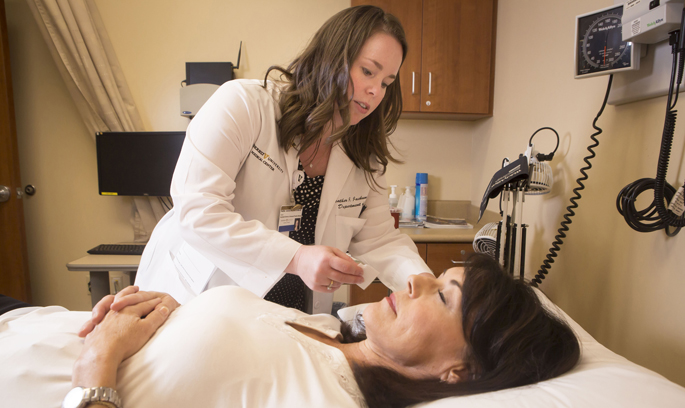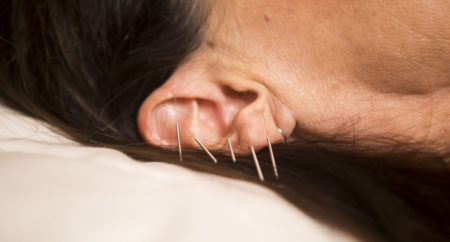
Franklin resident Diane Grich admits she was surprised when she was asked if she would like to try acupuncture instead of a more invasive medical procedure to address the chronic lower back pain that had troubled her off and on for 17 years; she chose acupuncture.
As she lay quietly in a treatment room at the Vanderbilt Interventional Pain Clinic, Heather Jackson, MSN, RN, APRN-BC, precisely placed five tiny needles into each of Grich’s ears; then she flipped off the room’s top light and left Grich alone with the needles in place for 20 minutes. Grich said the result was near immediate relaxation and pain relief. Since her first treatment, she has returned for a second time to receive what’s known as “battlefield acupuncture.”
“Whenever I’m stressed, it seems to immediately go to my back,” said Grich, who said a recent golf outing ignited her back pain. “This treatment relaxes me immediately and definitely dissolves that pain. The first time I got the treatment, the relief lasted five to seven days.”
Grich, 56, leads an active life, so she hated being immobilized by pain. Side effects from pain medications bothered her, and she had come to rely on other options including physical therapy, ice packs and steroid injections.
Receiving a minimally invasive treatment that has few side effects has been a welcome relief, Grich said.
Acupuncture originated in China more than 2,000 years ago, with the therapeutic intention of restoring the body’s balance and energy. Battlefield acupuncture is thought to calm the central nervous system and particularly an area of the brain that processes pain known as the cingulate gyrus.
The technique was developed by now retired Air Force Col. Richard Niemtzow, MD, in 2001 and has been used by the United States military for more than a decade.
Today, nearly 3,000 people from all branches of the military have been trained to provide the acupuncture treatment for both acute and chronic pain, as well as to reduce opioid over-prescribing and potential abuse. Because it is just as easily administered in a clinic as it is on the front line for a combat-wounded soldier, it was named battlefield acupuncture. Battlefield acupuncture was used by medics during air evacuations in the Gulf War, and acupuncture has been studied by the military as a therapy for a medical condition known as Gulf War Syndrome and for post-traumatic stress disorder (PTSD).
“For years I have been recommending acupuncture to patients, and the most common barrier was the cost, as it is not covered by insurance,” said Jackson, who has been certified to provide the treatment.
“I wanted to make acupuncture an accessible option for our patients.
“I initially brought the NADA protocol (National Acupuncture Detoxification Association) acupuncture therapy to Vanderbilt as an additional treatment option for patients undergoing opioid withdrawal. After I received the NADA training, I heard about battlefield acupuncture and realized the Veterans Health Administration was using this nationwide with their advance practice providers, so it seemed like a logical next step.”

To eliminate the cost barrier, Jackson offers battlefield acupuncture for $20 a session. Many patients also appreciate the short list of possible side effects: slight soreness, mild bruising and a very minimal risk of infection, she said.
After removing the needles from Grich’s ear following her treatment, Jackson offered her the option of leaving the clinic armed with an acupressure therapy she could self-administer. Grich was eager to give it a try as well.
Jackson carefully applied tiny, round flower seeds attached to squares of flesh-toned adhesive to specific pressure points inside Grich’s ears. She advised Grich to apply pressure or rub the points periodically, with the goal of continued relaxation and pain relief.
“I’m rubbing my ear right now, and I can already feel myself relaxing,” Grich said. “It was refreshing, really, to be offered this option, especially at a large medical center like Vanderbilt. I view acupuncture as an alternative medical treatment, and I applaud Vanderbilt for giving their patients this option.”
In acupuncture, the entire body can be treated with specified points in the ear, and the points where the needle are inserted are in line with the practice of acupuncture and the principals surrounding the body’s flow of chi, or energy, Jackson said.
“There are many studies that have promising results for the use of acupuncture across multiple disciplines and patient populations, but higher-quality randomized controlled trials with large sample sizes are definitely needed,” she added.
As growing emphasis is placed on reducing opiate use in the United States, the treatment of chronic pain is not “one-size-fits-all,” cautioned David Edwards, MD, Vanderbilt University Medical Center’s Chief of Pain Medicine.
“Long-term use of opiates is still an indispensable tool for many chronic, debilitating and severely painful conditions,” he said. “Vanderbilt Pain Management uses the best and most up-to-date medical evidence to treat pain. This approach targets the type of pain with medications specific for the diagnosis.
“Since the goal is improved function and quality of life, Vanderbilt’s treatment plans incorporate non-medication treatments (such as interventional procedures, acupuncture, yoga and physical therapy), non-opiate pain medications and opioids when appropriate and needed.”












